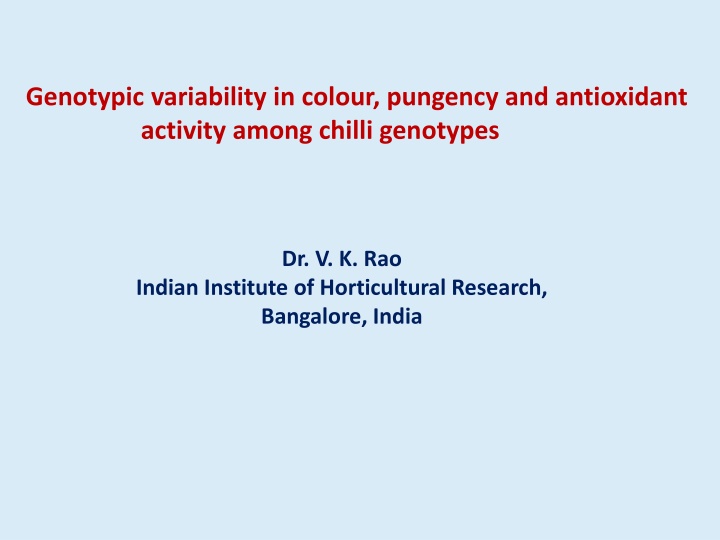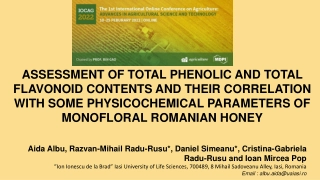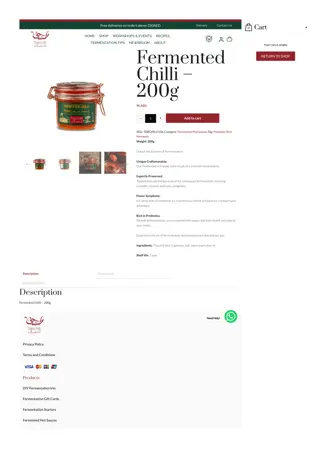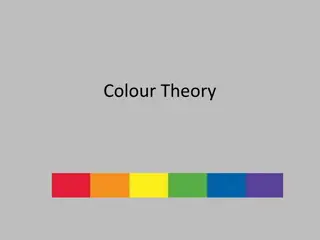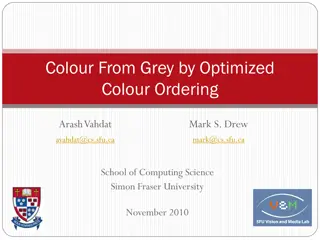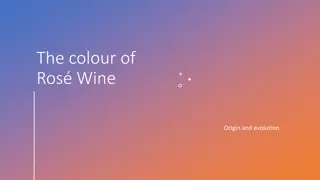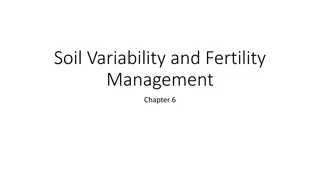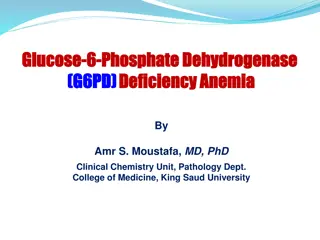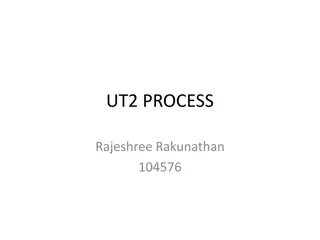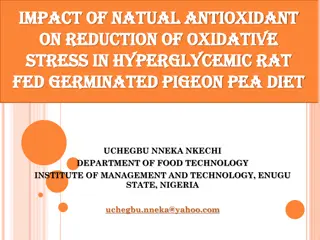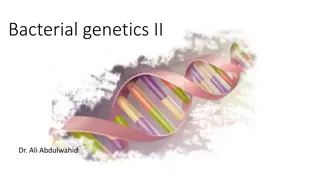Genotypic Variability in Chilli: Colour, Pungency, and Antioxidant Activity
This study explores the genotypic variability in colour, pungency, and antioxidant activity among different chilli genotypes, highlighting the importance of chillies as a major spice crop in India and various other countries. The research aims to analyze the extent of variability in key parameters such as pungency, colour, antioxidant activity, and more, among different chilli hybrids and varieties. Various chilli types, their uses, and the significance of chillies in the food industry are also discussed.
Download Presentation

Please find below an Image/Link to download the presentation.
The content on the website is provided AS IS for your information and personal use only. It may not be sold, licensed, or shared on other websites without obtaining consent from the author.If you encounter any issues during the download, it is possible that the publisher has removed the file from their server.
You are allowed to download the files provided on this website for personal or commercial use, subject to the condition that they are used lawfully. All files are the property of their respective owners.
The content on the website is provided AS IS for your information and personal use only. It may not be sold, licensed, or shared on other websites without obtaining consent from the author.
E N D
Presentation Transcript
Genotypic variability in colour, pungency and antioxidant activity among chilli genotypes Dr. V. K. Rao Indian Institute of Horticultural Research, Bangalore, India
Introduction 1. It is a major spice crop in India and some other countries 2. It is used for its pungency, flavour and colour. 3. India worlds largest producer, consumer and exporter of chillies 4. Apart from India, other major countries producing chillies are South Africa, China, Pakistan and Mexico. 5. It is grown in almost all parts of India under various climatic conditions. 6. Different types of chillies are grown to be used for different purposes. High pungent, low pungent, high colour value ones etc. 7. India exports chillies in the form of dry chillies, dry powder, pickled chillies and chilli oleoresins.
Usage 1. It is used in fresh green state, fermented state, dry red powder. 2. Other products include pickles, sauce and paste 3. Paprika color natural red colour - colouring substance in food industry 4. Oleoresin For flavour and colour in food industry
Variability in Chillies Size, colour, shape, pungency, flavour, texture etc.
Objectives 1. To study the extent of variability in pungency, colour, antioxidant activity, vitamin C and total phenols among hybrids / varieties developed at IIHR as well as in different varieties collected from other places. 2. To know the relation between pungency and other parameters in chilli hybrids / varieties. 3. To know the extent of contribution of each parameter towards variability through principal component analysis. 4. To know the extent of variability among the samples analyzed through hierarchical clustering.
Plant Material 1 2 3 4 Arka Khyati Arka Meghana Arka Swetha Arka Haritha Hybrid Hybrid Hybrid Hybrid 5 6 7 Arka Abhir Arka Suphal Arka Lohit OP variety OP variety OP variety 8 Andaman collection Natural cross of chinense vs frutescence ----do---- wastern ghats collection chinence grown in Nagaland exotic variety 9 Bhut Jalokia Local Toom 10 11 12 Kerala Collection Naga Chilli 13 Habanero
Parameters studied 1. Pungency by estimating capsaicinoids by HPLC (SHU units obtained by multiplication with 16.1 million) 2. ASTA colour value Spectrophometric method 3. Vitamin C Titrimetric method by using 2,6-dichlorophenol indophenol 4. Total phenols - spectrophotometric assay 5. DPPH radical scavenging assay spectrophotometric assay 6. FRAP antioxidant capacity assay - spectrophotometric assay
HPLC method for capsaicinoids analysis 1. Column : Onyx monolithic C18, 100 x 4.6 mm 2. Method: Gradient 3. Mobile phase: Water :Acetonitrile 4. Detection: 205 nm 5. Flow: 1.8 ml/min 6.Injection: 20 l 7. Std levels: 7 8. LOD: 0.01 g 9. LOQ: 0.03 g S. No. Time Acetonitrile % 1 0 8 minutes 30 % to 78 % 2 8.01 12 minutes 78 %
Capsaicinoids pungency compounds Capsaicin, Dihydrocapsaicin account for 90-96 % of capsaicinoids
Total Capsaicinoids in Chilli Varieties S. No. Total SHU Capsaicin Dihydro capsaicin % 34.4 34 34.2 38.9 39.6 33.5 37.6 26.1 15.9 23.1 26.9 22.4 25.1 CP/DC Variety capsaicinoids mg/g 0.1959 2.111 1.362 4.1708 0.1926 0.4742 1.9225 40.9646 27.7312 6.4686 8.5754 29.0245 11.6403 % Arka Khyati Arka Meghana Arka Swetha Arka Haritha Arka Abhir Arka Suphal Arka Lohit Andaman collection Bhut Jalokia Local Toom Kerala Collection Naga Chilli Habanero 1 2 3 4 5 6 7 8 9 10 11 12 13 3295 33988 21928 67151 3101 7636 30954 941901 493330 104145 141821 623269 243932 66.6 66 65.8 61.1 60.4 66.5 62.4 73.9 84.1 76.9 73.1 77.8 74.9 1.9 1.94 1.92 1.57 1.52 1.98 1.66 2.83 5.29 3.32 2.72 3.51 2.98 Large variation in pungency levels (3101 to 9.4 million SHU) was observed. CP/DC ratio also varied from 1.52 to 5.29.
Variation in CP/DC ratio with pungency level CP/DC 6 5 R = 0.3656 4 CP/DC 3 CP/DC 2 1 0 0 100000 200000 300000 400000 500000 SHU 600000 700000 800000 900000 1000000
Total phenols and pungency S. No Variety Pungency (SHU) Total phenols (mg/g) 1 2 3 4 5 6 7 8 Arka Khyati Arka Meghana Arka Swetha Arka Haritha Arka Abhir Arka Suphal Arka Lohit Andaman collection 3295 33988 21928 67151 3101 7636 30954 941901 8.4 9 8.7 9 8.7 7.2 9.3 33 9 10 11 Bhut Jalokia Local Toom Kerala Collection 493330 104145 141821 23 14 11 12 13 Naga Chilli Habanero 623269 243932 22 19
Total phenols and pungency 35 R = 0.9464 30 25 Total phenols mg/g 20 15 10 5 0 0 200000 400000 600000 800000 1000000 SHU
Function of dietary antioxidants Phytochemicals / antioxidants in diet Neutralize free radicals Prevent metabolic disorders / delay the onset of symptoms
Antioxidant capacity S. No Variety DPPH scavenging activity (mg/g AEAC units) FRAP antioxidant capacity (mg/g AEAC units) 1 2 3 4 5 6 7 8 Arka Khyati Arka Meghana Arka Swetha Arka Haritha Arka Abhir Arka Suphal Arka Lohit Andaman collection Bhut Jalokia Local Toom Kerala Collection 3.74 4.30 4.93 4.93 3.39 2.76 4.09 35.15 4.26 5.86 5.88 6.69 3.90 3.39 5.12 51.26 9 19.92 8.88 6.79 26.75 11.93 9.24 10 11 12 13 Naga Chilli Habanero 24.39 13.35 32.71 31.86
Comparison of antioxidant levels among varieties 60.00 50.00 40.00 Activity mg/g 30.00 DPPH FRAP 20.00 10.00 0.00 1 2 3 4 5 6 7 8 9 10 11 12 13 varities
Carotenoid pigments in chillies A. Red carotenoids capsanthin capsorubin
B. Yellow carotenoids zeaxanthin antheraxanthin mutatoxanthin -cryptoxanthin
Distribution of red and yellow carotenoids S. No. Variety Red yellow carotenoids (mg/100 g) Total Ratio carotenoids (mg/100 g) corotenoids mg/100 g (Red/Yellow) 1 2 3 4 5 6 7 Arka Khyati Arka Meghana Arka Swetha Arka Haritha Arka Abhir Arka Suphal Arka Lohit Andaman collection Bhut Jalokia Local Toom 147.0 119.6 130.8 80.7 154.8 125.7 87.3 109.7 94.9 145.7 65.5 113.1 98.7 38.8 256.7 214.5 276.4 146.1 267.9 227.8 126.2 1.3 1.3 0.9 1.2 1.4 1.3 2.2 8 9 45.9 45.9 40.8 28.8 30.0 94.7 74.7 75.9 135.5 1.6 1.5 0.4 10 11 12 13 Kerala Collection Naga Chilli Habanero 46.2 56.4 4.1 36.2 33.3 2.7 82.4 89.8 6.9 1.3 1.7 1.5
Comparative levels of red and yellow carotenoids 180.0 160.0 140.0 Red carotenoids (mg/100 g) 120.0 100.0 80.0 yellow carotenoids (mg/100 g) 60.0 40.0 20.0 0.0 1 2 3 4 5 6 7 8 9 10 11 12 13 Varieties
Total carotenoids and pungency Variety S.No. Total ASTA colour value Pungency (SHU) corotenoids mg/100 g 1 2 Arka Khyati Arka Meghana 256.74 214.48 98 82 3295 33988 3 4 Arka Swetha Arka Haritha 276.43 146.12 106 56 21928 67151 5 Arka Abhir 267.88 103 3101 6 Arka Suphal 227.77 87 7636 7 Arka Lohit Andaman collection Bhut Jalokia Local Toom Kerala Collection Naga Chilli Habanero 126.16 48 30954 8 9 10 11 12 13 74.72 75.88 135.49 82.37 89.77 6.87 30 30 53 32 35 3 941901 493330 104145 141821 623269 243932
Relation between total carotenoids and pungency 1000000 800000 600000 SHU 400000 Pungency (SHU) 200000 0 0 50 100 150 200 250 300 -200000 Total Carotenoids mg/100 g
Vitamin C in Chilli varieties S. No. Variety Vitamin C mg/100 g FW Pungency SHU 80000 70000 60000 Pungency SHU 1 Arka Khyati Arka Meghana Arka Swetha Arka Haritha Arka Abhir Arka Suphal Arka Lohit 77 3295 50000 40000 2 3 4 5 6 7 89.5 113 100 172 94 179.5 33988 21928 67151 3101 7636 30954 30000 20000 10000 0 0 50 100 150 200 Vitamin C mg / 100 g Pungency VS vitamin C
Principal component Analysis Principal Component Plot 1.5 1.0 ASTA colour value Andaman collection A Swetha A Abhir A Khyati 0.5 Pungency (SHU) DPPH Antioxidant activity mg/ g A Suphal Naga chilli PCA 2 (10.3%) Total phenols mg/ g DW A Meghana FRAP Antioxidant activity mg/ g DW 0.0 Bhut jalokia Local toom -0.5 A Harita A Lohit -1.0 kerala collection Habanero -1.5 -6 -4 -2 0 2 4 PCA 1 (88.6%)
Hierarchical Clustering Naga Chilli Bhut Jalokia Arka Lohit Arka Meghana Arka Swetha Arka Abhir Arka Khyati Arka Suphal Arka Haritha Local Toom Kerala Collection Habanero Andaman collection 0 111685399953 Hierarchical Clustering Distance/Similarity Measure = Squared Euclidean Distance Cluster Method = Nearest Neighbour
CONCLUSIONS 1. Large variation in pungency levels (3101 to 9.4 million SHU) was observed. CP/DC ratio also varied from 1.52 to 5.29 2. Total phenols correlated well with pungency levels. 3. Some of the varieties showed high antioxidant capacities as well as radical scavenging activities. Highly pungent varieties showed more antioxidant capacity. 4. Red capsaicinoids were more (up to 2.2 times) when compared to yellow ones except in one variety (local toom). 5. ASTA colour values varied widely from 3 to 106 among the varieties. It appears that there is a negative correlation between colour values and pungency. 6. Some of the varieties possessed high vitamin C content (179 mg/100 g FW) 7. Three distinct groups have appeared in PCA analysis indicating their similarity. PCA biplot indicates that values of all the parameters are positively correlated to each other except colour value. 8. Heirarchical clustering indicated that andaman collection is chemically different from all other varieties.
